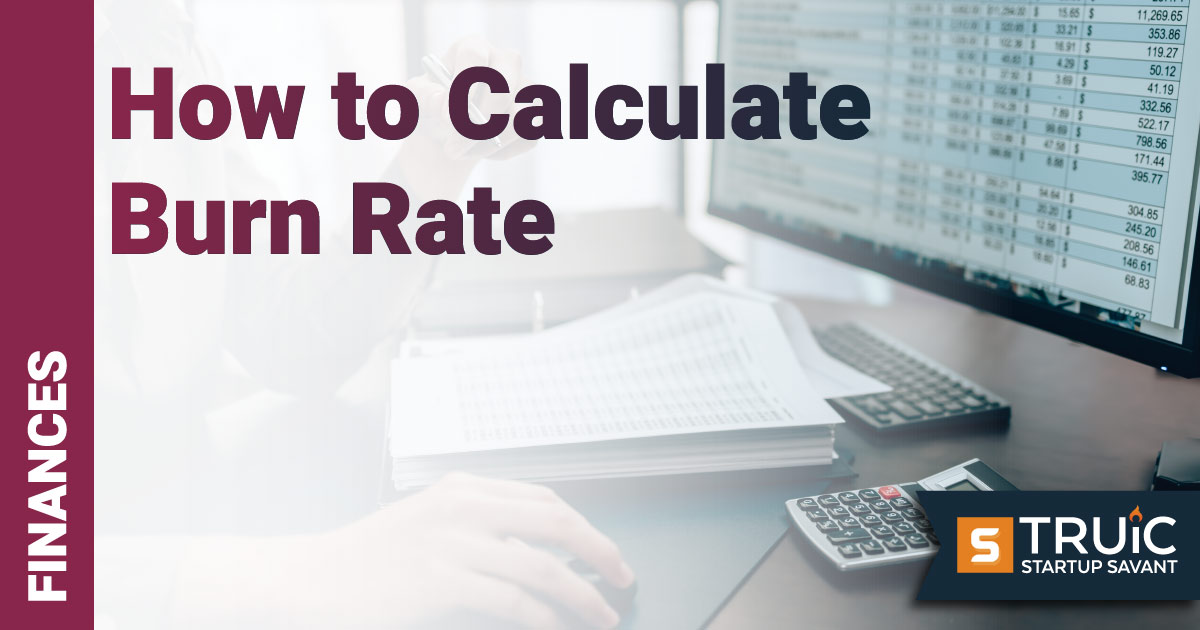How to Calculate Burn Rate for Your Startup

Last Updated: By Michaela Dale
Burn rate is a simple calculation for startups to deduce valuable information about the financial health of their company, its cash runway, where they’re losing money, and their funding needs. By comparing total operating costs per month with the growth and cash runway, startup founders can get a better idea of where their company is financially and where it is headed to make informed decisions for their business.
This guide walks you through what a burn rate is, why it matters, and how to calculate burn rate for your startup.
What Is Burn Rate?
Burn rate refers to the rate at which a company is spending its capital to finance overhead before generating positive cash flow from operations. It is usually calculated on a monthly basis.
The burn rate helps companies determine how long their current capital will last and when they may need additional financing to continue operations. A high burn rate may indicate a company is spending heavily on things like research, employee salaries, marketing, etc., before having revenue come in. A low burn rate shows capital is being used slowly as the company builds its business.
Monitoring burn rate lets companies forecast cash needs and make capital decisions accordingly. A spiking burn rate may prompt cost-cutting or the need to raise more funds soon. A steady or declining burn rate suggests financial health and sustainability. Balancing burn rate is an important aspect of managing a company's finances and growth.
Net Burn Rate vs. Gross Burn Rate
Gross burn rate refers to the total operating expenses of a company per month. It includes all costs needed to run the business, such as salaries, rent, marketing, and research and development. Essentially, the gross burn rate equates to your total monthly operating costs.
Net burn rate accounts for any revenue coming into the business and represents the actual loss per month after that revenue. Net burn rate equates to gross burn rate minus monthly revenue.
Gross burn rate remains fixed, while net burn rate fluctuates depending on sales.
Why Is Burn Rate Important?
Burn rate provides key visibility into a company's fiscal health and sustainability. It's a critical metric for planning, decision-making, and investor relations. Managing burn rate is essential for any business striving toward profitability.
Burn rate is an important metric for a few key reasons:
Cash Flow Management
Burn rate helps companies understand their cash outflows and how long their current capital will sustain operations. Tracking burn rate lets businesses forecast when they may need to raise additional funds to avoid running out of cash.
Runway Visibility
By calculating its burn rate, a company can estimate its "runway" or how many months it can continue operating before needing more capital. This runway figure is critical for planning and making strategic decisions. A shortening runway signals urgency.
Growth Decisions
Burn rate impacts a company's ability to invest in growth. A high burn rate may limit expansion plans unless more financing is secured. Companies need to decide if spending more now on things like hiring, marketing, or product development is justified by potential returns.
Profitability Benchmarking
Monitoring changes in burn rate indicates whether a company is moving toward profitability. As revenue grows, the burn rate should decline as reliance on capital decreases. The lower the burn rate, the closer a company is to becoming cash flow positive.
Investor Relations
VCs and investors want to see how efficiently a company is using capital. A spiking or high burn rate may make securing more funding challenging. Communicating plans to reduce burn can reassure investors.
Gross Burn Rate Calculation for Startups
To calculate monthly burn, you take the company's monthly operating expenses and divide it by the number of months remaining before projected positive cash flow. If you are doing a net burn rate calculation, you will need to subtract your monthly revenue as well.
1. Identify Your Operating Expenses
Total up all regular monthly costs. This may include payroll, rent, software subscriptions, hosting fees, and utilities. These are expenses needed to keep operating – otherwise known as operating costs.
2. Define Your Runway Timeframe
Next, you need to estimate the number of months remaining before your projected positive cash balance or profitability. This is typically 12 to 24 months for early-stage startups, though it will vary from startup to startup.
3. Divide Expenses by Runway
Finally, take your total monthly operating costs and divide them by the number of months you expect it will take to reach positive cash flow. This will give you your startup’s burn rate.
Burn Rate Example
Let's say a startup just secured $1 million in seed funding. Their projections show:
- Monthly operating expenses: $80,000.
- Projected timeline to break even or reach positive cash flow: 14 months
To calculate the startup's burn rate, we take the monthly operating expenses and divide it by the projected months to break even:
- Burn Rate = Monthly Expenses / Months to Break Even
- Burn Rate = $80,000 / 14 months
- Burn Rate = $5,714 per month
This means the startup is burning through $5,714 for every month of operations before they expect to reach positive cash balance.
With $1 million in capital, at this burn rate the company’s runway is:
- Runway = Total Capital / Monthly Burn Rate
- Runway = $1,000,000 / $5,714
- Runway = approx. 17.5 months
So, with a burn rate of $5,714 per month, the startup’s $1 million in funding will last for approximately 17.5 months before needing more capital.
Evaluating this burn rate of nearly $6,000 per month, leadership can assess if it aligns with their growth plans and milestones. If the burn rate is too aggressive, they may look to reduce operating expenses to extend their runway. If more progress is needed, they may justify increasing the burn rate through hiring or expansion efforts.
How to Reduce Burn Rate (and Extend Runway)
If your burn rate is too aggressive, you may need to consider reducing it and extending your runway. The best method to reduce burn rate varies depending on the startup and its operating expenses. These are a few common tactics for reducing burn rate:
- Review payroll and cut unnecessary roles or salaries if possible.
- Avoid over-hiring and outsource roles where you can to reduce headcount.
- Sublet or downsize office spaces to reduce rental overhead.
- Consolidate servers or optimize usage of cloud and hosting platforms.
- Cut back on discretionary expenses like merchandise, team meals, and company events.
- Limit company travel and entertainment.
- Offer discounts for early payment to increase cash flow.
- Raise a bridge funding round to get you by until your next funding round.
The best method for reducing burn rate and extending your startup runway depends largely on your current operating costs. Review where your startup is spending money that is not essential to the operation and success of your startup and consider eliminating or reducing those expenses.
Frequently Asked Questions
What is the formula for burn rate?
To calculate monthly burn rate, you take the company's monthly operating expenses and divide it by the number of months remaining before projected positive cash flow.
For example, if a company spends $120,000 per month and expects to turn cash flow positive in six months, the burn rate is $120,000 / 6 months = $20,000 per month.
How do you calculate the burn rate for hours worked?
Calculating burn rate based on hours worked can be done in a few steps. First, determine your total monthly costs. This includes all salaries, benefits, payroll taxes, and any other expenses associated with your team's hours worked per month.
Then, calculate the total number of hours worked in a month across your team. Add up the hours logged by each employee. Finally, divide your total monthly costs by the total number of labor hours worked in the month.
What is a good burn rate percentage?
There is no universal "good" burn rate percentage that applies to all companies. The general rule of thumb is to aim for a 20% net burn rate and 20% growth rate.


